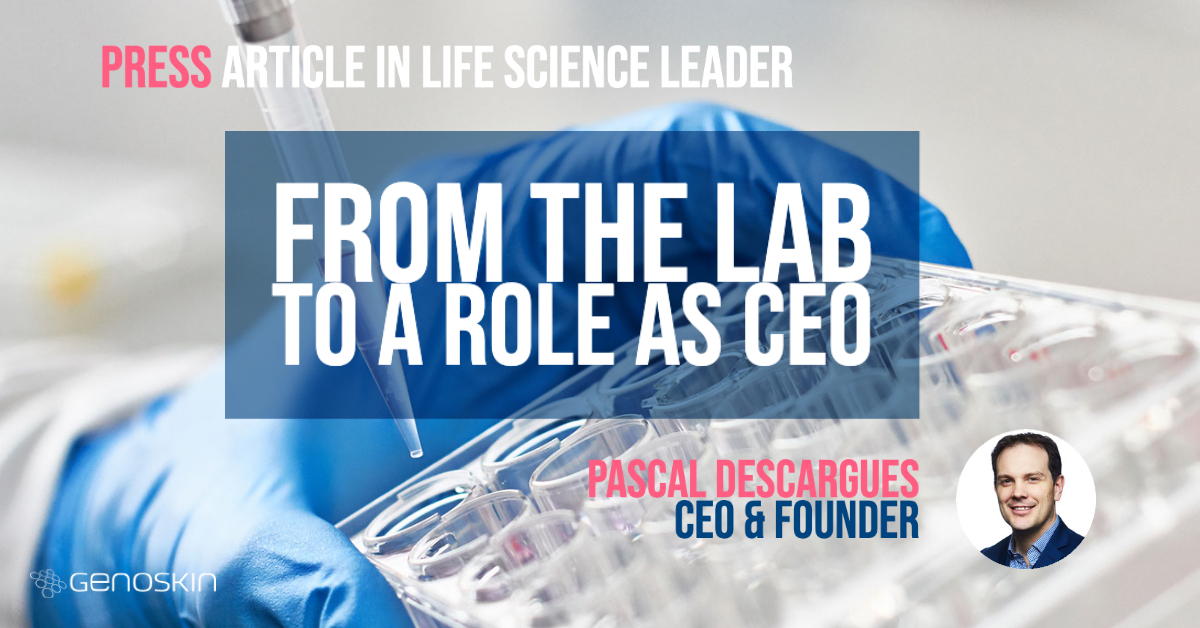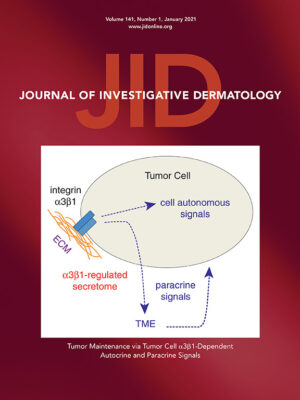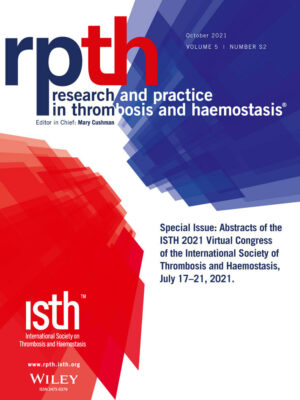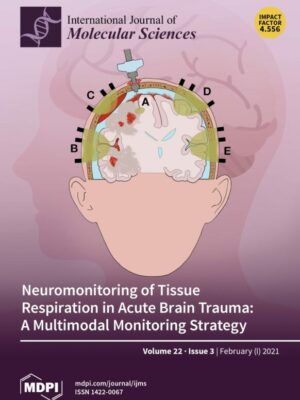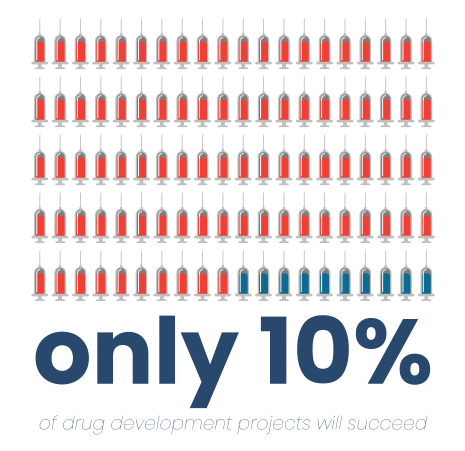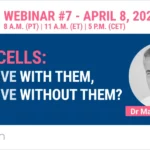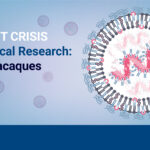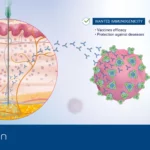Article by Pascal Descargues, first published in Life Science Leader on February 1, 2022. The original article is available here.
What I Learned In A French Lab That Led To My Role As CEO
The Path to the Aha Moment
In 2006, I had just finished my Ph.D. in human pathophysiology, and I was working in a lab in Toulouse, France studying gene functions in mice. Starting a biotech company was not my focus at that particular time, but it was my work and research in this lab that sparked Genoskin’s birth. I was working on a rare inherited genetic disorder that affects the skin, hair, and immune system, known as Netherton Syndrome. Babies born with the syndrome are afflicted with red scaly skin, and in severe cases, are susceptible to infection, which can be life-threatening.

After replicating the disease in animals, our teams located the gene that is mutated. From there, our research focused on the enzymes that triggered the skin’s redness and scaling in humans. Our next step was the catalyst that led to my “aha moment.” We had to check our findings in humans, but since we weren’t able to access skin from the babies afflicted, we turned back to the mice. Everything failed. The mice’s skin was not useful because it was not applicable to humans. I knew that there had to be a better way and the answer seemed obvious and almost too simple.
We looked to partner with a local hospital in France. I knew that skin is discarded from electable surgical procedures, but what I didn’t realize is how much skin is actually thrown away. In France alone, a quick google search led me to the estimated 20,000 tummy tucks a year. In the US, the number is 10 times that. We estimated cumulatively that you could cover 10 football fields with all that discarded skin. That’s a lot of skin!

I went on to complete a 2-year post-doctoral fellowship at the University of San Diego California after I wrote my thesis, “Development and characterization of a mouse model of Netherton syndrome: toward the identification of drug target.” Eventually, I came back to the lab and began working on a project to develop adequate human skin models that are more accurate, ethical, and help in accelerating drug development, saving time, costs, and most importantly, human life. There was no blueprint for this company, or model to follow. To our knowledge, at this writing, we are the only company with a live ex vivo skin model used in subcutaneous drug testing. Our innovations didn’t happen overnight. From the very beginning, we knew that we would need to partner with others to be successful.
Embracing Collaboration
In biotech and biopharma organizations, it’s important to create a culture that supports collaboration, triumphs, and even perceived “failures.” A biopharma partnership can produce scientific and financial resources and is a way to share the risks of taking your technologies through development and ultimately a route to seeing that these products reach the intended market.
- Meeting and Missing Endpoints: As scientists, we learn valuable lessons from each other’s successes and even failures or missed opportunities. I remind our teams daily that we learn from each other’s scientific trials, whether in direct collaboration or not, and always advance the science as a result.
- The Perfect Partner: The perfect business partner remains elusive, but through collaboration, companies can strike the right chord that hopefully translates into a meaningful working relationship. Back in the lab in 2009, I knew that to be successful, I would need to collaborate. So, I turned to the French National Center for Research and the Paul Sabatier University for support. Together, we developed the science and grew the company into an international biotech.
- Attending Conferences: Just as I did, when you are in the early stages, it’s a good idea to search for companies active in your field with experience. Key conferences , websites and biopharma events are a good place to start looking for potential companies, which may be identified through partnering meetings via virtual, or actual in person networking events.
- Creating Publications and Securing Media Interviews: If you have public data that supports your new therapy, or technology, submit a paper to a journal for publication. Appearing in a reputable scientific journal will raise awareness and provide validation from the scientific community. An article in a biotech publication, even with other companies, can also raise your profile. As a new company, you have to start somewhere. Begin securing media interviews early. As your science develops, so will the media’s interest.
Hope for the Best, Plan for the Worst
As leaders, we can plan for success and prepare for failure. Building a versatile nimble strategy, enables our teams to continue developing the science and technologies, while we as leaders protect the bottom line.
- The Backup Plan: In the lab, the academic setting, and corporate America, all leaders must understand how critical it is to develop a strategy that entails two separate tracks. Plans should pivot around key data readouts or technology and mitigate any risk from turning into an issue that may negatively affect development. A backup plan may mean the difference between success and failure. It also protects your employees, science and instills confidence from the board.
- Accountability: A major factor in strategy should include execution and the commitment to holding each other accountable against key milestones. Although our teams are working in different time zones all over the world, I pride myself on making myself approachable and available. I share my daily tasks and goals with the team, but let them work on their own. Each and every position is important to our overall strategy within Genoskin and every team member knows that. As a leader, I try to lead with an eyes on and hands off mentality.
- Raising Money: As a first time CEO, raising money was a learning curve for me. Our company was able to thrive on grants in the beginning stages, but as our technologies developed, we needed more money to grow. We worked on developing a clear financing plan that was not tied to a single technology.
Staying Motivated
As I’ve traveled the world meeting with potential investors, drug developers, and fellow scientists in academia and pharma, I’m often asked the very same question. “What inspired me to start this company?” The answer is always the same: ethics and science motivated me to find a better way to bring drugs to market faster. With greater consumer and regulatory pressure to move away from animal experimentation, it is our responsibility as scientists to invent a better model.
Pharma and research institutions are realizing that animal testing is an insufficient predictor of drug safety or efficacy in humans. More than 90% of drugs entering clinical trials fail, despite positive results in preclinical animal tests. And most of these drugs fail because of toxicity or loss of efficacy, which are not properly detected in animals. We are providing a solution to help scientists access human data even before starting a clinical trial in humans. Just as I learned in the lab 15 years ago when testing for Netherton Syndrome, the old model, the use of animals, isn’t always applicable. There is still no cure for Netherton Syndrome. It’s my hope that one day there will be a breakthrough treatment, and that Genoskin’s skin models will be critical in developing a safe and tolerable treatment for these newborns.
Comments are closed.

